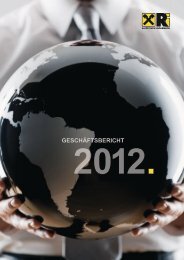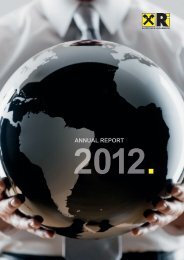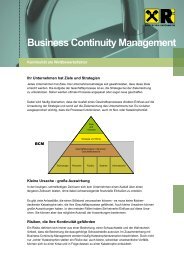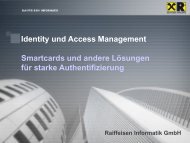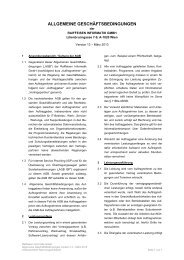ANNUAL REPORT - Raiffeisen Informatik
ANNUAL REPORT - Raiffeisen Informatik
ANNUAL REPORT - Raiffeisen Informatik
- No tags were found...
Create successful ePaper yourself
Turn your PDF publications into a flip-book with our unique Google optimized e-Paper software.
IV.3. SERVICES FOR THE RAIFFEISEN BANKING GROUP<strong>Raiffeisen</strong> <strong>Informatik</strong> is a full service IT company for thecustomers of the <strong>Raiffeisen</strong> Group. In 2012, comprehensiveIT services were provided to 107 <strong>Raiffeisen</strong> bankswith 606 branches, for the regional <strong>Raiffeisen</strong> banks with116 branches, <strong>Raiffeisen</strong> Zentralbank, <strong>Raiffeisen</strong>bankInternational and Zveza Bank. Apart from the banks,<strong>Raiffeisen</strong> <strong>Informatik</strong> customers are companies such as<strong>Raiffeisen</strong> Bausparkasse, <strong>Raiffeisen</strong> Leasing, <strong>Raiffeisen</strong>Capital Management and Valida Pensionsversicherungsanstalt.Austria’s largest IT service provider managed 5.9 millionbank accounts and executed over 7.4 billion bankingtransactions. The online operations required <strong>Raiffeisen</strong>banks to run 329 servers and 8,987 clients.Prominent credit institutions such as Porsche Bank,Société Générale, Notartreuhandbank AG, Vakif Bank,Anglo Irish Bank (Austria) AG, Generali Bank AG andBankhaus Schellhammer & Schattera use the IT servicesof <strong>Raiffeisen</strong> <strong>Informatik</strong>.EINE IT FÜR RAIFFEISEN ÖSTERREICHIn January 2011, the project “Eine IT für <strong>Raiffeisen</strong>Österreich” was started for the harmonization of thebanking software for all <strong>Raiffeisen</strong> banks. With the newstandardized <strong>Raiffeisen</strong> banking software, a high qualityIT system both as regards the technology and contentis made available and which has been designed toperfectly cover the needs of the <strong>Raiffeisen</strong> BankingGroup Austria. The objective is, above all, to takeadvantage of greater synergy and efficiency potentials.A uniform IT infrastructure is needed for the smoothoperation of all harmonized banking applications forthe decentralized servers and clients. This requires thereplacement of the hardware of all field servers andclients to standard models. As preparation, a joint,nation-wide call for tenders and procurement wasorganized for the first time for the <strong>Raiffeisen</strong> BankingGroup (except for Salzburg). The magnitude of 25,000jobs highlights the synergy potentials of the project.The new “<strong>Raiffeisen</strong> Client” and the new “<strong>Raiffeisen</strong>Server” were rolled out successively at the <strong>Raiffeisen</strong>banks in Austria. By the autumn of 2013, all workplaceswill have been changed over to Windows 7 in Austria.The new hardware generation for clients is excellentlyequipped with 8 GB memory, the latest processor andSSD hard drives.<strong>Raiffeisen</strong> <strong>Informatik</strong> upgraded the fixed line networkin the region of the <strong>Raiffeisen</strong> banks in Vienna, LowerAustria and Burgenland and for the credit banksPosojilnica. The bank offices will be connected to thedata centre irrespective of their technical setup via fibreglass, copper lines or radio relay technology. At thesame time, the bandwidth in the banking network willbe upgraded from currently 2 to a minimum of 6 Mbit/sand all network components such as routers andswitches will be replaced by new generation devices.At the same time, with the installation of the new fieldserver and the clients, a new smartcard will be usedthroughout Austria. The established solution of 2-factorauthentication with the use of smartcards is integratedinto conventional operating systems. As a high-securitytechnology for digital certificates, this technology isalso the basis for other important application areas suchas digital signatures and encryption. The new smartcarduses the latest card technology that offers even greatersecurity through new functionalities in the authenticationprocesses and improved encryption. With this newplatform for decentralized systems and the new smartcard,all of the technical requirements have beenestablished for the project “Eine IT für <strong>Raiffeisen</strong>Österreich”.PERSONNEL ADMINISTRATIONAT THE HIGHEST LEVELSince recently, <strong>Raiffeisen</strong> <strong>Informatik</strong> has been offeringcomprehensive personnel administration solutionsreferred to as PVI (Personalverwaltung und Information,personnel administration and information). After theinstallation at <strong>Raiffeisen</strong>landesbank Niederösterreich-Wien where this system is already operating smoothly forsome 1,700 employees, the rollout is now being carriedout in further companies of the <strong>Raiffeisen</strong> Banking Groupin the provinces of Lower Austria and Burgenland. Thecorporate and employee master data of the around110 related companies with over 5,500 employees weresuccessfully transferred from the old system to the newPVI applications.The PVI module can be used internationally and enablesefficient administration, short routes and clear decisions.The advanced, user-friendly and reliable technologymeets all conventional security requirements. Standardizationand quality assurance in the routine processesare ensured thanks to the high degree of automationof workflows. All data are available via a uniform interfaceand operation logic without redundancies.The cloud model SaaS (Software-as-a-Service) was usedin the service design of the personnel software. Thismeans that the software and the IT infrastructure requiredfor the <strong>Raiffeisen</strong> <strong>Informatik</strong> data centre is operatedcentrally. This means that customers do not need to incurexpenses for technical installations or for operations.The users of the application only need a PC with Internetaccess and a connection to <strong>Raiffeisen</strong> <strong>Informatik</strong>. Accessto the application is easy and done via the web browser.Companies that use this model do not need to acquireand manage licenses, have no operating expenses,because <strong>Raiffeisen</strong> <strong>Informatik</strong> takes over the completeIT administration, maintenance work and updates.The highly modern data centre of <strong>Raiffeisen</strong> <strong>Informatik</strong>undergoes regular security audits in accordance withstate-of-the-art standards to ensure all relevant securityaspects. A separate Security Competence Centerprovides permanent disruption-free operation. Thismakes it possible for <strong>Raiffeisen</strong> <strong>Informatik</strong> to permanentlyprotect all important data and the confidentiality of thepersonal data.RAIFFEISEN LEASING –A CLOSER LOOK AT IT COSTSA benchmark comparison is conducted to analyze the ITcosts of <strong>Raiffeisen</strong> Leasing. <strong>Raiffeisen</strong> <strong>Informatik</strong> wasalso requested to implement an Active Cost Management(ACM) project within the scope of this contract. The ITcosts of comparable international companies (peergroup) are analyzed based on a well-founded model. TheACM is based on extensive information on the customersand the corresponding benchmark data supplied byGartner – an information technology research andadvisory company. The figures and information providedby <strong>Raiffeisen</strong> Leasing relating to personnel and costsare carefully validated based on <strong>Raiffeisen</strong> <strong>Informatik</strong>’smany years of experience and the relevant key performanceindicators calculated. These were then comparedwith the peer group. The analysis covers severalbusiness years at various levels – both financially and asregards technology.The result of this benchmark analysis has shown thatthe IT of <strong>Raiffeisen</strong> Leasing has no need to be shy of anycomparison with international peers. The IT costs arein the middle range of the peer group. Those areas thatdeviate significantly from the benchmark values wereinvestigated in more detail. A detailed analysis was madeto ascertain the source of these deviations and if thedeviations are one-time effects or systematic. Thesedeviations were clarified at coordination talks and jointmeasures to further reduce costs were discussed.ALARM CONTROL:DIAL-UP CONTROL FOR ALARM SYSTEMSThe 100% functioning of alarm systems is a highlysensitive area in the security infrastructure of every bank.Only if the alarm functions flawlessly is it possible forthe police to take quick action, for example, in the case ofan attack on an ATM connected to an alarm networksystem. Before the backdrop of customer demand andinsurance regulations, an automated check of the alarmfunction (telephone line and alarm dialup device) wasconducted daily at the <strong>Raiffeisen</strong> banking branches inVienna, Lower Austria and Burgenland. In March 2012,<strong>Raiffeisen</strong> <strong>Informatik</strong> conducted a broad functional checkof the alarm dialup devices.The devices sent alarms daily at specified points in timefor simulation purposes. Only if it is fully executed isthe alarm call considered successful. If a call is missedFinancial Statements Certifications and Awards Risk Management CSR Group Management Report Group Profile Corporate Bodies / Shareholders Preface44 45




